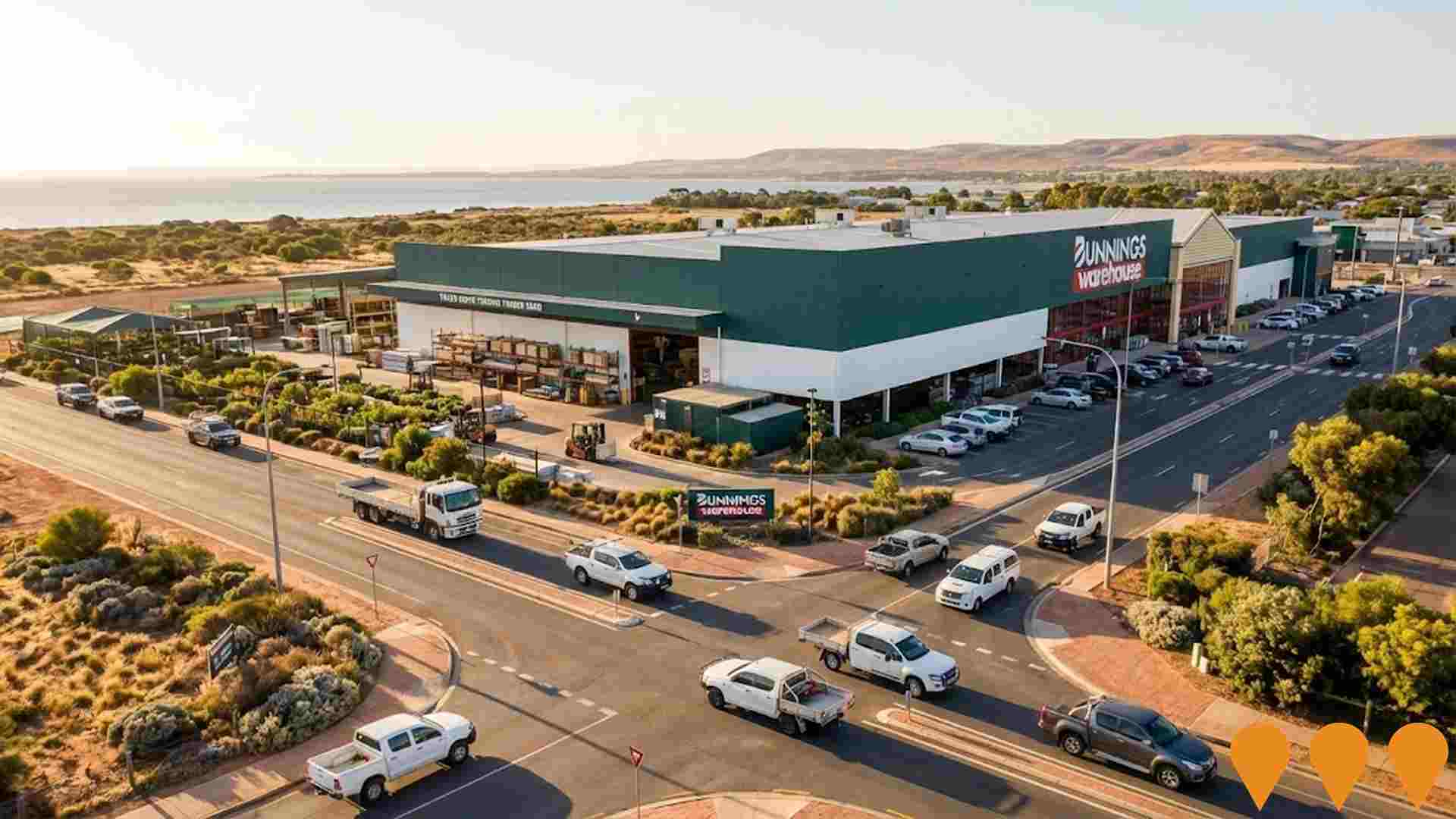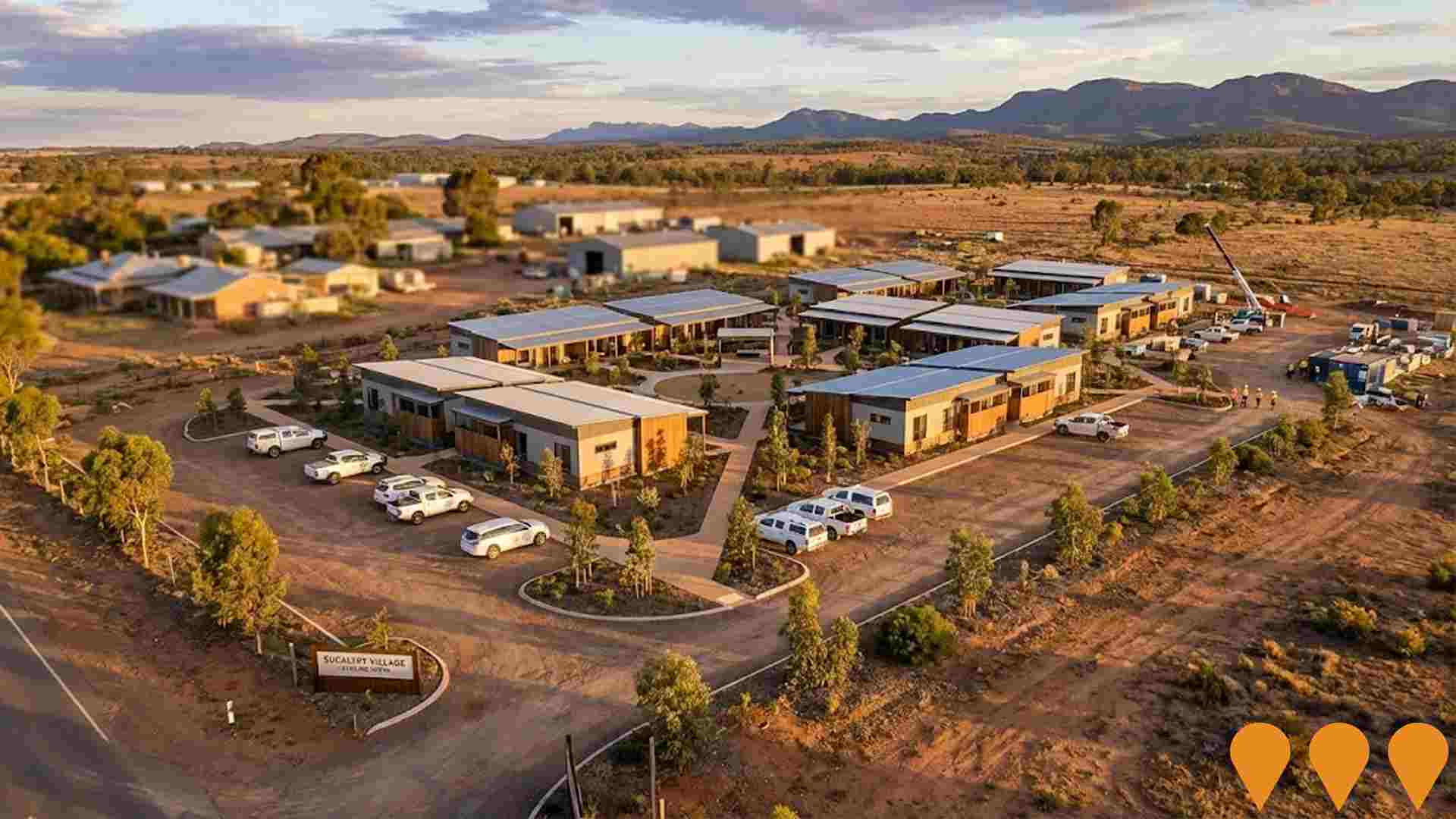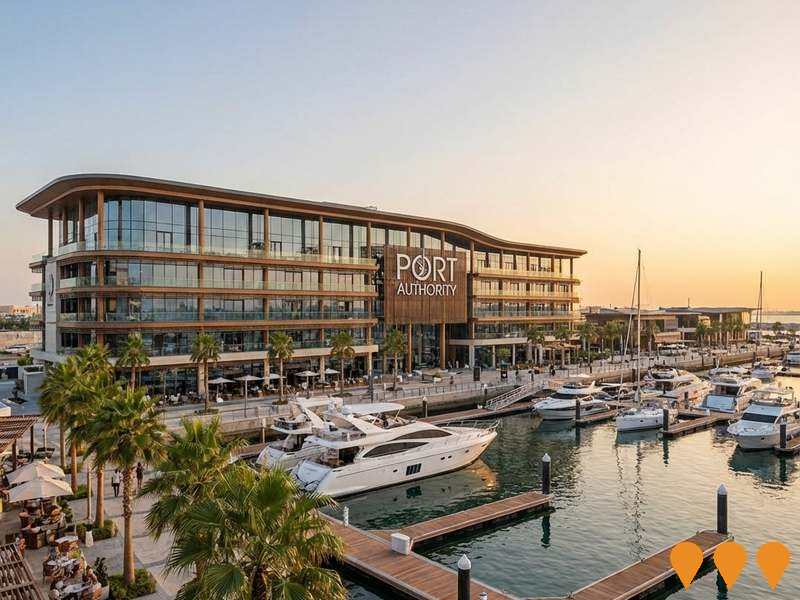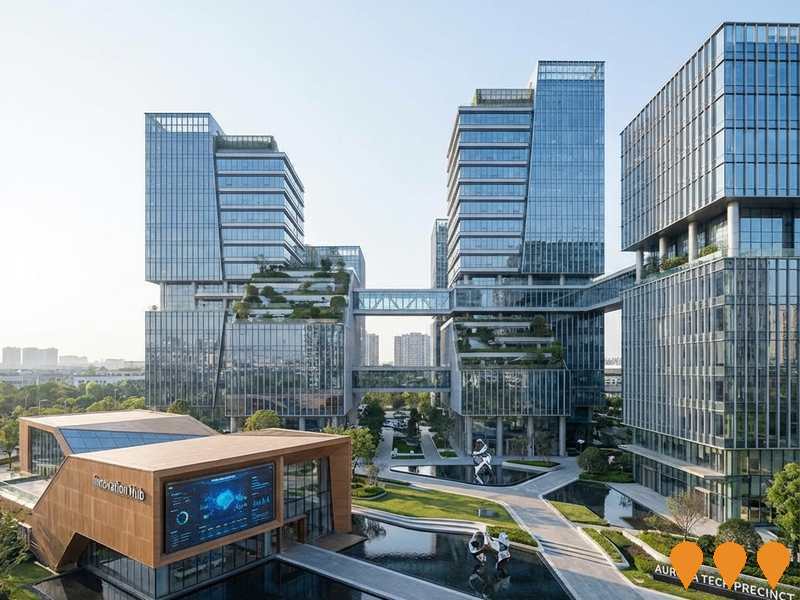Chart Color Schemes
est. as @ -- *
ABS ERP | -- people | --
2021 Census | -- people
Sales Activity
Curious about local property values? Filter the chart to assess the volume and appreciation (including resales) trends and regional comparisons, or scroll to the map below view this information at an individual property level.
Find a Recent Sale
Sales Detail
Population
Quorn - Lake Gilles has shown very soft population growth performance across periods assessed by AreaSearch
Quorn - Lake Gilles' population is approximately 2,218 as of August 2025. This figure reflects an increase of 76 people (3.5%) since the 2021 Census, which reported a population of 2,142. The change is inferred from the estimated resident population of 2,190 in June 2024 and an additional 19 validated new addresses since the Census date. This results in a density ratio of 0.10 persons per square kilometer. Over the past decade, Quorn - Lake Gilles has shown resilient growth patterns with a compound annual growth rate of -0.3%, outperforming the SA3 area. Interstate migration contributed approximately 65.2% of overall population gains during recent periods.
AreaSearch uses ABS/Geoscience Australia projections for each SA2 area, released in 2024 with 2022 as the base year. For areas not covered and years post-2032, the SA State Government's Regional/LGA projections by age category are adopted, based on 2021 data and adjusted using a method of weighted aggregation from LGA to SA2 levels. Population projections indicate a decline in overall population by 41 persons by 2041. However, specific age cohorts are expected to grow, notably the 75 to 84 age group projected to increase by 118 people.
Frequently Asked Questions - Population
Development
AreaSearch assessment of residential development drivers sees a low level of activity in Quorn - Lake Gilles, placing the area among the bottom 25% of areas assessed nationally
Quorn - Lake Gilles has recorded approximately eight residential properties granted approval each year over the past five financial years, totalling forty homes. In FY26 so far, zero approvals have been recorded. On average, 0.1 new residents per year arrive for each new home constructed between FY21 and FY25. This indicates that new construction is meeting or exceeding demand, providing buyers with more options while enabling population growth.
The average value of new homes being built is $430,000. This financial year has seen $1.2 million in commercial approvals, demonstrating the area's residential nature. Compared to the rest of South Australia, Quorn - Lake Gilles records 166.0% more construction activity per person. Development activity has moderated recently, with new building activity showing an equal split between detached houses (50.0%) and medium to high-density housing (50.0%). This shift from the current 94.0% houses suggests diminishing developable land availability and responds to evolving lifestyle preferences and housing affordability needs. The estimated population count of 402 people per dwelling approval reflects its quiet, low activity development environment.
With population expected to remain stable or decline, Quorn - Lake Gilles may see reduced pressure on housing, potentially creating opportunities for buyers.
Frequently Asked Questions - Development
Infrastructure
Quorn - Lake Gilles has moderate levels of nearby infrastructure activity, ranking in the top 50% nationally
Area infrastructure significantly impacts local performance. AreaSearch identified 53 projects likely affecting the area. Notable projects include Eucalypt Village - Stirling North Accommodation Development, Joy Baluch AM Bridge Duplication, McIntosh Crescent Road Resealing, and Bunnings Warehouse Port Augusta. The following list details those most relevant.
Professional plan users can use the search below to filter and access additional projects.
INFRASTRUCTURE SEARCH
 Denotes AI-based impression for illustrative purposes only, not to be taken as definitive under any circumstances. Please follow links and conduct other investigations from the project's source for actual imagery. Developers and project owners wishing us to use original imagery please Contact Us and we will do so.
Denotes AI-based impression for illustrative purposes only, not to be taken as definitive under any circumstances. Please follow links and conduct other investigations from the project's source for actual imagery. Developers and project owners wishing us to use original imagery please Contact Us and we will do so.
Frequently Asked Questions - Infrastructure
Bunnings Warehouse Port Augusta
The new Bunnings store in Port Augusta has officially opened, featuring a 5000 square meter space with a nursery, landscaping area, two-lane trade drive-through timber yard, and an outdoor living and barbecue area. The store was staffed almost entirely by Spencer Gulf locals.

Eucalypt Village - Stirling North Accommodation Development
A purpose-built 90-room accommodation village at 22 Range View Road, Stirling North, providing dorm-style rooms, motel-style units and studio apartments for essential workers, students and practitioners linked to services such as health, emergency services and education in the Port Augusta region. The project is planned to be delivered over multiple stages with construction intended to commence in 2025 and an indicative completion around 2026, subject to planning and environmental approvals.

St Eyre Estate
A residential estate development located in Port Augusta West, with infrastructure for Stages 4 & 5A already in place, including roads, curbing, power, and water. These stages are available as a whole parcel to be subdivided into 60 spacious allotments, each approximately 1200 square meters. The vacant allotments allow for custom home builds, and the development is set against the scenic Baxter Ranges, with proximity to the Flinders Ranges and Spencer Gulf.

McKinnon Court Residential Development
This is a 3,100 square meter residential land lot in Port Augusta West, South Australia, that is available for sale. It is being marketed as an ideal location to build a dream home, a few courtyard homes, or to subdivide into smaller allotments, subject to council consent. The property is located next to a playground.

Cleary Street Residential Subdivision
A prime development opportunity in Port Augusta West, the 1.4 hectare site is zoned R-Residential and has a preliminary development plan to be subdivided into 18 allotments, subject to council approval. The land is on the market for sale.

McIntosh Crescent Road Resealing
Sections of roadway on McIntosh Crescent in Port Augusta West require resealing due to deterioration and wear. The project will use a two-coat bitumen spray seal with a crumbed rubber binder.

Joy Baluch AM Bridge Duplication
Duplication of the Joy Baluch AM Bridge to improve road safety and efficiency for all users, improve freight productivity, and improve the resilience of this critical road link. It will also address the current bridge speed restrictions and safety for people walking or cycling across the bridge. The project is part of the Port Wakefield to Port Augusta (PW2PA) Regional Projects Alliance. The duplication of the bridge is an important link in the National Land Transport Network at Port Augusta.

Port Augusta Technical College
A new technical college co-located on the Port Augusta Secondary School site, providing an alternative senior secondary option that equips students with the workplace skills needed in areas of high demand. One of five technical colleges committed to by the State Government as part of a $208 million plan. The Technical College will open in 2025.

Employment
Employment performance in Quorn - Lake Gilles has been broadly consistent with national averages
Quorn-Lake Gilles has a diverse workforce with both white and blue-collar jobs, an unemployment rate of 3.8% as of June 2025, and estimated employment growth of 4.8% over the past year. The area's unemployment rate is 0.8% lower than Rest of SA's rate of 4.6%, with workforce participation at 51.9%.
Key industries include agriculture, forestry & fishing, health care & social assistance, and accommodation & food services. Employment specialization in mining is high, at 2.6 times the regional level, while manufacturing representation is lower at 1.8% compared to the regional average of 9.3%. Many residents commute elsewhere for work based on Census data. In the 12 months prior, employment increased by 4.8% alongside a labour force increase of 5.7%, raising unemployment by 0.8 percentage points.
This contrasts with Rest of SA where employment contracted by 1.2%, and unemployment rose by 1.2 percentage points. National employment forecasts from Jobs and Skills Australia (May 2025) project growth of 6.6% over five years and 13.7% over ten years, but local growth patterns may differ based on industry-specific projections.
Frequently Asked Questions - Employment
Income
The area's income levels rank in the lower 15% nationally based on AreaSearch comparative data
According to AreaSearch's aggregation of the latest postcode level ATO data released for financial year 2022, Quorn - Lake Gilles had a median income among taxpayers of $47,536. The average income stood at $57,543. This is lower than the national average and compares to levels of $46,889 and $56,582 across Rest of SA respectively. Based on Wage Price Index growth of 12.83% since financial year 2022, current estimates would be approximately $53,635 (median) and $64,926 (average) as of September 2025. Census 2021 income data shows household, family and personal incomes in Quorn - Lake Gilles all fall between the 5th and 18th percentiles nationally. The earnings profile shows that 29.4% of locals (652 people) are in the $400 - $799 income category, contrasting with the region where the $1,500 - $2,999 bracket leads at 27.5%. Housing costs are modest, with 90.4% of income retained, but the total disposable income ranks at just the 11th percentile nationally.
Frequently Asked Questions - Income
Housing
Quorn - Lake Gilles is characterized by a predominantly suburban housing profile, with above-average rates of outright home ownership
In Quorn - Lake Gilles, as recorded in the most recent Census, 94.1% of dwellings were houses, with the remaining 5.9% consisting of semi-detached homes, apartments, and other dwelling types. This differed from Non-Metro SA's composition of 85.7% houses and 14.3% other dwellings. The home ownership rate in Quorn - Lake Gilles was higher at 50.4%, with mortgaged dwellings making up 29.0% and rented ones comprising 20.6%. The median monthly mortgage repayment in the area was $964, lower than Non-Metro SA's average of $1,138. The median weekly rent figure in Quorn - Lake Gilles was recorded at $175, compared to Non-Metro SA's $187 and the national average of $375 for mortgage repayments and $240 for rents respectively.
Frequently Asked Questions - Housing
Household Composition
Quorn - Lake Gilles features high concentrations of lone person households, with a lower-than-average median household size
Family households account for 60.8% of all households, including 16.7% couples with children, 34.4% couples without children, and 8.4% single parent families. Non-family households constitute the remaining 39.2%, with lone person households at 37.9% and group households making up 2.2% of the total. The median household size is 2.0 people, smaller than the Rest of SA average of 2.4.
Frequently Asked Questions - Households
Local Schools & Education
Quorn - Lake Gilles faces educational challenges, with performance metrics placing it in the bottom quartile of areas assessed nationally
The area's university qualification rate is 13.9%, significantly lower than the Australian average of 30.4%. This discrepancy presents both a challenge and an opportunity for targeted educational initiatives. Bachelor degrees are most common at 11.3%, followed by graduate diplomas (1.4%) and postgraduate qualifications (1.2%). Vocational credentials are prominent, with 41.7% of residents aged 15+ holding such qualifications - advanced diplomas at 10.7% and certificates at 31.0%.
A substantial 23.5% of the population is actively pursuing formal education, including 10.2% in primary, 5.7% in secondary, and 2.4% in tertiary education. Educational provision includes Quorn Area School and Hawker Area School, serving a total of 173 students. Both schools offer integrated K-12 education, providing continuity throughout students' academic journey. The area has 7.8 school places per 100 residents, below the regional average of 15.4, with some students likely attending schools in adjacent areas.
Frequently Asked Questions - Education
Schools Detail
Nearby Services & Amenities
Transport
No public transport data available for this catchment area.
Frequently Asked Questions - Transport
Transport Stops Detail
Health
Health performance in Quorn - Lake Gilles is well below average with prevalence of common health conditions notable across both younger and older age cohorts
Quorn-Lake Gilles faces significant health challenges, with common conditions prevalent across both younger and older age groups. Private health cover is low at approximately 48% (~1,071 people), compared to 53.1% in Rest of SA and a national average of 55.3%. The most common conditions are arthritis (11.8%) and asthma (7.5%), with 61.6% reporting no medical ailments, compared to 68.2% in Rest of SA.
The area has 33.2% residents aged 65 and over (737 people), higher than the 16.3% in Rest of SA. Senior health outcomes are above average, outperforming general population metrics.
Frequently Asked Questions - Health
Cultural Diversity
Quorn - Lake Gilles is considerably less culturally diverse than average when assessed alongside AreaSearch's national rankings for language and cultural background related metrics
Quorn-Lake Gilles had a cultural diversity score below average, with 88.6% of its population being Australian citizens, 91.7% born in Australia, and 95.6% speaking English only at home. Christianity was the predominant religion, comprising 47.8% of the population, compared to 41.6% across the rest of South Australia. The top three ancestry groups were Australian (32.2%), English (31.6%), and Australian Aboriginal (8.1%).
Notably, German ancestry was overrepresented at 5.7%, Scottish at 7.9%, and South African at 0.3%.
Frequently Asked Questions - Diversity
Age
Quorn - Lake Gilles ranks among the oldest 10% of areas nationwide
Quorn - Lake Gilles has a median age of 54, which is higher than the Rest of SA figure of 47 and Australia's national average of 38 years. The 65-74 age group makes up 19.3% of the population in Quorn - Lake Gilles, compared to 12.0% in the Rest of SA and 9.4% nationally. Meanwhile, the 35-44 age group is less prevalent at 8.5%. Between 2021 and present, the 75 to 84 age group has grown from 9.0% to 11.6%, while the 15 to 24 cohort increased from 7.0% to 9.1%. Conversely, the 45 to 54 cohort has declined from 12.3% to 9.5%, and the 0 to 4 group dropped from 5.5% to 3.8%. By 2041, demographic modeling suggests significant changes in Quorn - Lake Gilles's age profile. The 85+ group is projected to grow by 194%, reaching 155 people from the current 52. This growth will be led by residents aged 65 and older, who represent all anticipated growth. Conversely, both the 25 to 34 and 15 to 24 age groups are expected to decrease in number.



